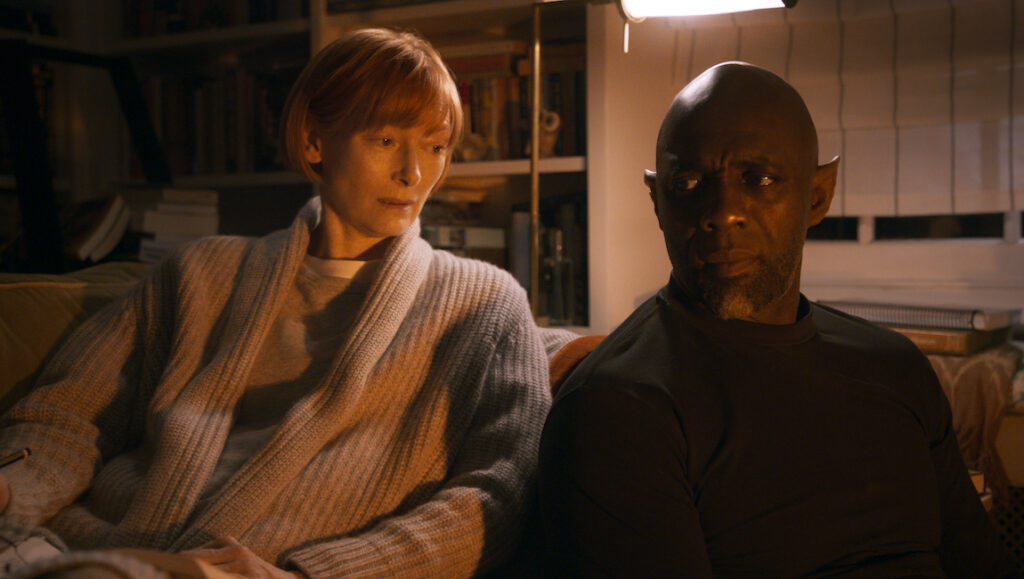Three Thousand Years of Longing presents a fairly stimulating academic study in its early going, but ultimately fails to balance its conceptual and emotional aims.
In brief outline, the premise of Three Thousand Years of Longing, George Miller’s long-awaited follow-up to Mad Max: Fury Road, sounds like the start of a bad joke: A narratologist (Tilda Swinton) and a Djinn (Idris Elba) walk into a hotel room… Adapted from A. S. Byatt’s short story “The Djinn in the Nightingale’s Eye,” the film is easily described. While attending an academic conference in Istanbul, London-based academic Alithea Binnie (Swinton) picks up a memento in the city’s Grand Bazaar. Back in her hotel, she ends up releasing the Djinn contained within the object, who offers her the usual three wishes, after which he will finally be freed from his imprisonment. She, though, being an expert in narrative structure, knows that there is no story about wish-granting that doesn’t function as a cautionary tale. Accordingly, she chooses not to make any request, saying that she is, after all, perfectly content with her life. In an attempt to convince her to change her mind, or perhaps simply to pass the time, the Djinn tells her the stories associated with his imprisonment, recreated in CGI-heavy recreations, interpolated by running annotations from Alithea.
Three Thousand Years is transparently a reflection on the myths and stories which lurk beneath all human activity, and what happens when these are not complemented but crowded out by a worldview that sees scientific materialism as the most real thing: What happens when one refuses to keep alive a metaphorical and mythical way of using words and images, falling back only on a knowledge composed of stubborn “facts”? On this score, the film is fairly stimulating. Working essentially as a two-hander, the film is initially driven by the dialogue between Alithea and the Djinn, subordinating its dramatic interest to conceptual play — something like Arabian Nights enfolded into a humorous lecture in comparative mythology. When the two first meet, for instance, the Djinn does not know English — but fortunately, Alithea is able to speak in “the language of Homer,” and is able to holster the conversation until the Djinn learns English from absorbing the information contained in floating electromagnetic waves. But after a certain point, things shift, and this conceptual dimension slowly gives way to the relationship between Alithea and the Djinn. The former finally admits that there is in fact something that she wants — she is human after all, and to be human is to be finite, and to be finite is to desire — and what she wants is to be loved, to be recognized by another. So she wishes for one thing: to be loved by the Djinn.
Three Thousand Years is, in other words, meant to transform from a conceptually stimulating dialogue into an earnest romance. The problem is that the film remains largely on the conceptual level, its emotional pull remaining largely theoretical. (This would be less of an issue if Miller’s sensibility or facility for action direction were present in the individual stories themselves, but there is, likewise, little to hang onto there.) Despite its cosmic scale, Three Thousand Years does not quite match the conceptual giddiness conveyed by, say, Guy Maddin’s The Forbidden Room (2015), with its mise-en-abyme into stories and its literal “Book of Climaxes.” More crucially to its intentions, the film is unable to bridge the gap between its conceptual interest and its desired emotional impact. By the end, the film is transparently an allegory, with the Djinn and Alithea representing, respectively, myth and concept, creation and knowledge, perhaps even beauty and truth. But for all of the film’s attempts to reforge the broken links between the two, its appeal remains largely academic.
Published as part of Cannes Film Festival 2022 — Dispatch 1.


Comments are closed.